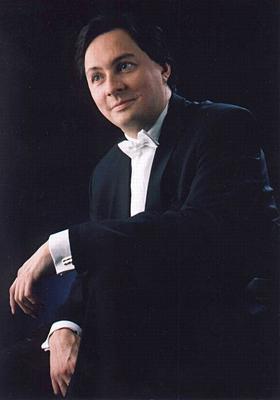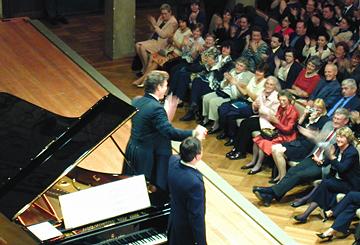|
<< -- 2 -- Sissy von Kotzebue AN EVENING FULL OF HAMPSONGS

The genial German-born pianist Wolfram Rieger accompanies in a very sensitive way regarding both the demands of the composition and the needs of the singer. As a trained baritone himself, Rieger breathes with the singer and reacts to potential difficulties before they can happen. Very often, a composer does not consider that even the best singer must breathe, and builds phrases that are impossible to sing as a whole. If the singer does not want to break a narrative phrase by breathing, then often the only way to survive is to accelerate the tempo, giving it an additional dramatic accent, or to begin with less power and then increase towards the end. Rieger proves his quality in these cases, by playing with the tempi and dynamics.

Wolfram Rieger
|
Unlike some singers who still struggle with these kinds of problems, Hampson knows how to cope with long sentences, a result of planning them cleverly together with his accompanist. Their partnership forms such an important aspect of Hampson's career as a Liedersänger that the local newspaper Abendzeitung, one of the largest here, devoted a large section of its review to Rieger and his extraordinary skill on the piano. In fact, during the instrumental passages preceding or ending some songs, Hampson cedes the limelight to Rieger, from whom the concert pianist breaks out to deliver some fine piano playing that could easily attract its own audiences, sans singer. Rieger prefers being an accompanist to being a concert pianist. He likes the partnership with great singers, and it is only fitting that a singer like Hampson, of whom we have come to expect only the very best, should come with such a fine accompanist in tow.

Thomas Hampson and Wolfram Rieger acknowledge applause from their Munich audience. Photo © 2004 Sissy von Kotzebue
|
After the Liszt Lieder, applause rushes over Hampson and Rieger. The two men, who genuinely like each other and are friends in private life as well, leave the stage arm in arm, then return, increasing the applause to beyond fortissimo.
After two minutes of repose, five of the Wunderhorn Lieder are on the programme. Hampson leads his public into the world of war, a genre that represents a chapter of its own in Mahler's work. Particularly, one can find aspects of the composer's Bohemian homeland, as in the more folksongish 'Aus, aus!' In other pieces, the art of Mahler's symphonic composition becomes clear in the piano notation: in 'Zu Straßburg auf der Schanz', where bass trills are, as Mahler instructed, to imitate the subdued sound of drums.
Continue >>
Copyright © 24 July 2004
Sissy von Kotzebue, Munich, Germany

|

